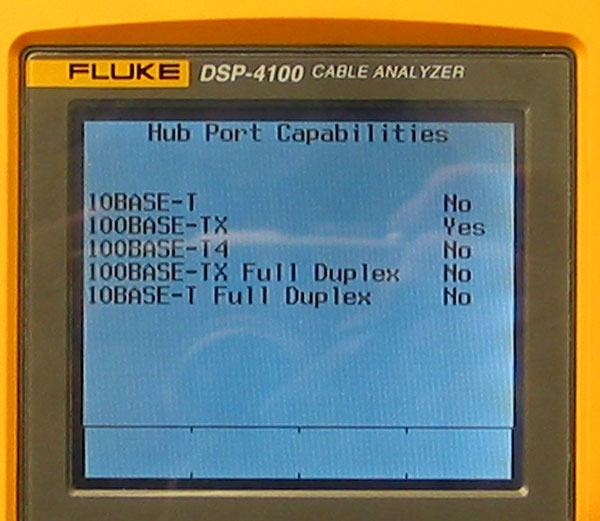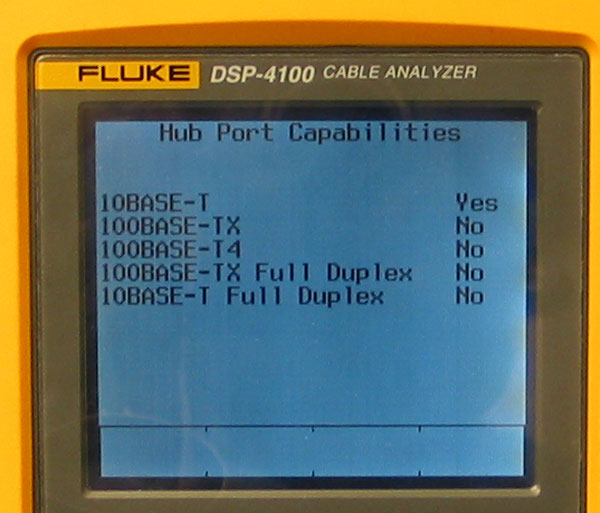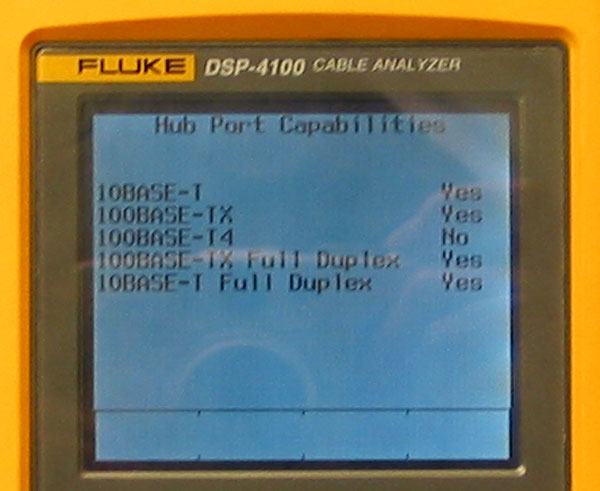Switch Port Discovery
This is the method that I use to determine how a switch port is setup
when I do not have access to the switch.
The Fluke will grab the FLP settings and provide some feedback

100 forced Duplex, (you do not know if it is Half or Full)

10 forced Duplex, (you do not know if it is Half or Full)

Auto Auto
EtherPeek will fill in the remaining information
| Type |
Field |
Definition |
| Ox0001 |
Device ID |
The name of the neighbor device and either the MAC address or the serial number of this device. |
| Ox0002 |
Entry address(es) |
A list of network addresses of neighbor devices. |
| Ox0003 |
Interface |
The protocol and port number of the port on the current device. |
| Ox0004 |
Capabilities |
The device type of the neighbor. This device can be a router, a bridge, a transparent bridge, a source-routing bridge, a switch, a host, an IGMP device, or a repeater. |
| Ox0005 |
Software Version |
The software version of the neighbor device. |
| Ox0006 |
Platform |
The product name and number of the neighbor device. |
| Ox000? |
Holdtime |
The remaining amount of time, in seconds, the current device will hold the CDP advertisement from a transmitting router before discarding it. |
| Ox0001 |
[network protocol] address |
The network address of the neighbor device. The address can be in IP, IPX, AppleTalk, DECnet, or CLNS protocol conventions. |
| Ox0009 |
VTP Management Domain |
A string that is the name of the collective group of VLANs associated with the neighbor device. |
| Ox000a |
Native VLAN |
The ID number of the VLAN on the neighbor device. |
| Ox000b |
Duplex Mode |
The duplex state of connection between the current device and the neighbor device. |
0x0004 Capabilities Flags
| 01 |
02 |
04 |
08 |
10 |
20 |
40 |
Bit |
Description |
| 0 |
|
|
|
|
|
|
0x01 |
Performs level 3 routing for at least one network layer protocol. |
| |
0 |
|
|
|
|
|
0x02 |
Performs level 2 transparent bridging. |
| |
|
0 |
|
|
|
|
0x04 |
Performs level 2 source-route bridging. A source-route bridge would set both this bit and bit 0x02. |
| |
|
|
1 |
|
|
|
0x08 |
Performs level 2 switching. The difference between this bit and bit 0x02 is that a switch does not run the Spanning-Tree Protocol. This device is assumed to be deployed in a physical loop-free topology. |
| |
|
|
|
0 |
|
|
0x10 |
Sends and receives packets for at least one network layer protocol. If the device is routing the protocol, this bit should not be set. |
| |
|
|
|
|
1 |
|
0x20 |
The bridge or switch does forward IGMP Report packets on nonrouter ports. |
| |
|
|
|
|
|
0 |
0x40 |
Provides level 1 functionality. |
Capabilities
Type: 4
Length: 8
Capabilities : 0x00000028 Switch IGMP
|